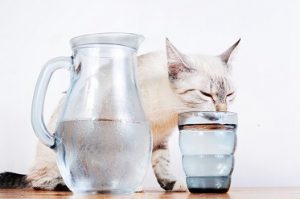We all know kitties are very stoic about their health. They typically don’t let you know anything is going on until it’s advanced enough for you to notice on your own. By then it can be pretty tough to treat, and sometimes even too late to save her. Kitties as a species are generally prone to kidney disease. One way you can “get ahead and stay ahead of the 8 ball” early on is with her hydration. When kitties don’t feel well, they generally just go hide somewhere. Problem is, while they’re hiding, they’re not drinking water. Kitties get very dehydrated very quickly and this is really hard on their delicate kidneys. So what can you do to help prevent trouble?

How To Identify If Your Kitty Is Dehydrated.
How to tell your little one is dehydrated? As a loving kitty owner, you need to be very aware of your kitty’s behavior at all times so you can read the signs early. If you suspect kitty is not feeling well, pinch the skin up and down her back. Does it stay pinched and loose when you let go? Then she’s dehydrated. Make it a habit every day when you’re loving on your kitty to do the pinch test. Also, does she hover/linger over her water dish? She’s dehydrated. So, establish the good habit to support her kidney health by ensuring that she’s always hydrated. How do I do that? First of all, START EARLY. Don’t wait until she shows signs of kidney trouble. When the signs start, she’s already in trouble.
A Good Fountain Is Excellent Support For Kitty’s Hydration And Health.
The best way to help your kitty stay hydrated, hands-down, is with a food-grade ceramic drinking fountain and a good filter. Kitties are naturally fascinated by running water, which is a big help. Just leave a faucet on somewhere in the house and watch them come running. No doubt you’ve seen the cute videos on YouTube of kitties and faucets. I’ve discovered that even a kitty that’s not feeling well will hang around a fountain or running faucet. You can use this to your kitty’s advantage. Don’t wait for her to develop signs of poor kidney health. Start her on a fountain when she’s young to help discourage kidney troubles down the road.
Choosing A Fountain.
Having fresh water available to kitty at all times is paramount. Having a running fountain of fresh filtered water is even better, because it attracts her even when she’s not feeling well. This is an especially important time for her to be drinking more water. There are many places you can buy pet fountains. Definitely avoid plastic units. Plastic harbors bacteria. Ideally, you want a “food-grade” ceramic fountain–food-grade ceramic like the dishes people eat and cook on, not the ceramic that art pieces are made of because art glazes contain lead.
After much online research, I found “Fountains by Ebi” (http://ebifountains.com/).
You can custom-order the fountain to your liking as far as size and look and what type of filter you want in it. I’ve been using my Ebi fountain for several years now, and I promise you from personal experience it is one of the BEST INVESTMENTS you’ll ever make for your kitty’s health.
Added Hydration Support.
A kitty that’s already dehydrated will have a tough time drinking enough water to re-hydrate herself, even at the fountain. In these instances, you can give her a little extra support with “sub-q” fluids. Sub-q fluids must be prescribed by your veterinarian. It’s like a bag of IV fluid that you see in hospitals. The bag comes with a line, and you can use 10-20 needles per bag depending on the level of distress your kitty is in, and how much fluid your veterinarian recommends for her.
Before You Run Screaming For The Hills, Hear Me Out.
Your veterinarian can show you how to give the fluids to your kitty. Don’t be afraid of it. You just pull up a pinch of skin over her shoulders and insert the needle under the skin. Don’t go any deeper into tissue or muscle–just under the surface of the skin. The first time or two you’ll feel awful, like you’re hurting her. I almost fainted, because I’m afraid of needles. So I was feeling guilty for kitty AND i was trying not to throw up. But you’ll quickly get the hang of it and be able to insert the needle without her even noticing, especially because you know you’re helping her.
The needle simply goes just under the skin, NOT into a vein or muscle. Her body will quickly absorb the fluids and she’ll be feeling like a million dollars again in less than 30 minutes. I’ve found that having kitty sit in the bathroom sink while I give her the sub-q fluids helps to discourage her from struggling. She seems to feel safe all snuggled down in it. And I’m not wrestling with her to stay still, so the whole process is easier on both of us. She relaxes quite comfortably in the sink for the two or three minutes it takes to dispense the fluids under her skin. When you’re finished, massage her skin at the injection site for a couple of seconds to ensure the fluids don’t leak back out, and Voila! You’re done and she’s already on her way to feeling better. Sub-q fluids are lifesavers–the best and fastest support for a dehydrated kitty and for a kitty with kidney disease.
Sub-Q Fluids Are Tremendous Support, But Not A Cure.
NOTE: Sub-q fluids are not a cure for kidney disease. They simply offer her much-needed comfort and desperately needed hydration that she can’t get on her own by drinking water. I make it a point to keep a supply of sub-q fluids and needles on-hand at all times. In my rescue organization, we’ve saved more lives by having sub-q fluids immediately available right when we need them, rather than having to wait for a scheduled appointment and an emergency run to the vet. Hydration isn’t just a matter of the kitty’s comfort. It can be a matter of her life, and time and treatment are of the essence. It’s a glorious feeling to know you’re caring in such a great way for this precious little soul. Because of you, she has the healthiest, most wonderful life.
Here’s a cute video of Princess, a Milagro Senior (www.milagropets.org). She actually prefers to drink from our little fish tank instead of the kitty fountain. There are no fish in it, but Princess enjoys it so much we keep it set up just for her. And that’s cool, too. As long as it’s clean and she’s drinking, that’s the main thing. See how you can make the critical act of staying hydrated fun for your kitty? Be creative.
So your take-away tip on this subject – invest in a food-grade ceramic fountain for your kitty or, like Princess, a running fish tank. Be very sure the water is always clean, and always always always make sure she’s hydrated. If your kitty needs more critical care, ask your veterinarian about sub-q fluids.
** ** ** ** ** ** ** ** ** ** ** ** ** ** ** ** ** ** **
God Bless and Happy Pet Parenting!
With love and good wishes,
jeannie.
About jeannie: I’ve been pro-actively involved in pet rescue all of my life. I founded Milagro Senior Pet Refuge© (Phoenix) in 1998, and BareFootPets (TM) in 2008. Animal welfare has always been and will always be my heart’s work. If my only legacy is that I save a handful of precious souls that would not survive otherwise, I’m good with that.

